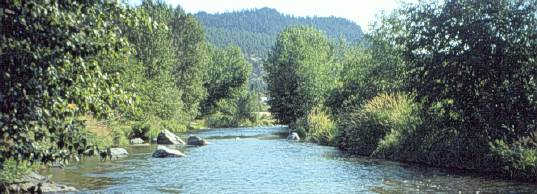Aquatic Invertebrates of Montana
Recommendations

Due to the lack of information, we need adaptive management here, that is, we learn a little and then we do a little. We will then learn a little more so that we can do a little more. We also need to preserve our options as much as possible. We may not always do the right thing, but hopefully we will learn the right thing. We will learn much more by doing something than by merely watching. Even in failure, one consolation is that you learn more than with simple success. I do not known the best approach at this time, but a few options seem apparent already.
- Install a fish barrier between Lyons Creek and Seiben Flats. Most of the spawning
occurs below this limit anyway and there is no need to send spore-loaded spawning
fish into the worm-filled mudholes of the middle drainage. With luck, the parasite
may not reach that area at all, but it probably will.
- Remove natural fish barriers from the worm-free spawning streams, Sheep, Wolf and
Lyons Creeks. These streams should also get increased protection as might be possible
once their value to the fishery becomes more clear.
- Forget the Dearborn River, except to monitor for the parasite in the fish. This is
a large system, but it is very similar to Little Prickly Pear Creek in many ways.
We can concentrate on Little Prickly Pear Creek first and extend the results to the
Dearborn River if and when solutions are found. Of course, with our adaptive approach,
we will return attention to the Dearborn River immediately if any interesting clues
are found there.
- If and when the middle parts of Little Prickly Pear Creek become an important source
of TAMs:
- Study the ability of filter-feeding insects to destroy free-floating TAMs. This might be done in the lab anytime. In the field it might be possible to encourage TAM destruction in a shallow, high gradient flume with rough surfaces. In this stream, such areas are densely covered with filter-feeding insects.
- Study the affects of standing water on TAM survival. This too might be done in the lab. In the field it might be possible to reduce TAM loading to the lower stream with a small seasonal impoundment at the lower end of Seiben Flats.
- Look for other barriers to block TAMs in natural streams. Tubifex populations that
are mostly limited to headwater areas or to tributary streams, may not be as rare
as first thought. I have 2 more examples developing- more on this latter. Detailed
information on the life history requirements and limitations of the parasite between
the worm and the fish will be key here.
- If and when the canyon area of Little Prickly Pear Creek supports a major parasite
load:
- Cleanup worm hot-spots by removing the few major backwater areas that still exist by direct habitat reconstruction. This should reduce both Tubifex and spore retention.
- Study the affect of brown trout spore loading by blocking them from part of the drainage
with a seasonal fish barrier. Spore retention in the canyon of Little Prickly Pear
Creek is likely to be short. The spores left by dyeing brown trout in the fall might
be most dangerous as they are available to the worms in time to infect the emerging
young trout in the next spring.
- If and when all of the above fail to save the recruitment from Little Prickly Pear
Creek- we go to plan B, which involves a comprehensive redesign of the land and water
use practices in the middle parts of the drainage. Tubifex should not be in this drainage
and it will not survive there if the human impacts on the drainage are sufficiently
lowered. This is only normal water and soil conservation, which is often in the best
long-term interest of all parties.
-
If and when the Missouri River itself infects too many of the returning young fish too much: (Note that working on the Missouri River tributaries is of no direct value if the young fish are all destroyed in the Missouri River anyway, but the results might be most useful elsewhere.)
- Study the seasonality of TAM activity along the course of the river. There are patterns in temperature and Tubifex density that may affect this.
- Modify the discharge volume and temperature of the Missouri River dams as might be possible to reduce the overlap of TAMs and the young returning fish.
- Modify the discharge and in-stream habitats in the worm-free spawning streams to reduce
the exposure of the young fish to the Missouri River TAMs.
16 OCT 1996, updated on 26 OCT 1996 D.L. Gustafson
Back to the Little Prickly Pear Creek
